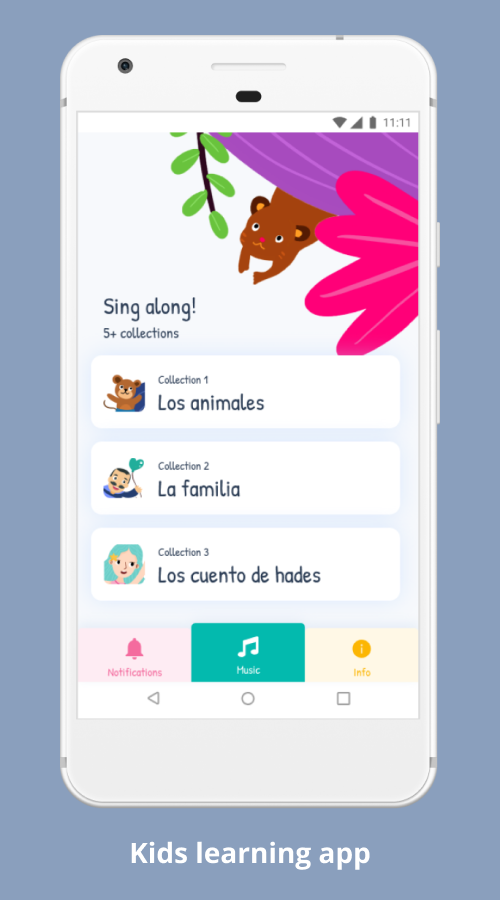-DOIT Software is your technology satellite for sustainable growth.
We offer:
1. Development of Mobile Apps & Custom Software Development from scratch. DOIT Software can help you to evolve an idea and create a solution from the concept.
2. IT Staff Augmentation and Recruitment of the best professionals in the industry. DOIT Software helps to extend teams and to create full-cycle Dedicated Development Teams who work remotely as a part of your company.
Check our latest publications:
- Flutter vs Kotlin comparison
- Apps like kik comparison
- Apps like Snapchat
- Why a discovery phase is important?
- Full list of Rabbit alternatives
- Apps like showbox
- Where to choose developers for your project - Toptal vs Upwork comparison
Focus Areas
Service Focus
- Mobile App Development
- Web Development
- Software Development
- IT Services
- Business Services
Client Focus
- Medium Business
- Small Business
Industry Focus
- Education
- Healthcare & Medical
- Business Services
DOIT Software Executive Interview

DOIT Software offers:
- Staffing of the best professionals in the industry. DOIT Software provides professionals that work remotely to supplement teams within a client’s company.
- Development of Custom Mobile Apps & Software Solutions from scratch. DOIT Software can help clients develop a solution by taking an idea from concept to creation.
In addition to IT expertise, DOIT Software also has its own experience in startups and new business development. We're professional in Mobile App creation (native iOS, Android, React Native, Flutter), Web Solutions, Back-End, UX/UI, QA, and Data Science Team Augmentation.
My role as CEO involves observing, analyzing, and optimizing all key processes of our company. My main goals are to create a sustainable team and processes that will allow the company to scale. The basis of it is a comprehensive customer-centric approach.
We have several examples of us using the outsourcing model with a client and then after everything was delivered as they expected, they liked working with us and were willing to continue cooperation. It’s the best way to continue with team extension and provide the client with a dedicated developer (or developers) who works entirely on their project for 6+ months.
Now, you may be wondering what can be offered next in addition to a complete product team. Right now we are offering the next step - a dedicated team in a separate branded office with all processes set up, integrated team culture, and ongoing support in technical, recruiting, and administrative areas.
With some of our clients, we work together for more than 2-3 years and have 2 and even 3 projects. I need to say that we have a high repetitive ratio, and we’ve received good referrals from our existing clients, who have recommended us to their partners and friends.
The main ones are:
- The number and complexity of the functionality that the customer wants to see in their product.
- This is an essential factor in the development time range calculation. There are simple applications, and there are also quite complex solutions.
- We always recommend setting priorities for functions and developing them in stages. This allows you to bring the product to market earlier and be quite flexible according to its needs. A very practical approach for new products is to launch MVP (minimum viable product) first in order to validate their business idea.
- Communication and involvement of the customer
- It is challenging to build useful projects, without communication, even if you have very experienced team members. This is one of the crucial elements.
- The results are usually much better when someone from the customer's side is involved in the role of Product Owner. Business requirements and their priorities are better defined, the team is quickly informed about new requirements, and so on.
- Level of experience and number of specialists in the team
- We always recommend involving the right number of people with the right level of experience that is needed in each project.
- It is worth remembering that quantity does not always mean better quality or speed.
- At the same time, it is crucial to cover all the needs of the team from a professional point of view. It's hard to build a solution quickly if you don't have a QA (quality assurance) engineer or PM (project manager). The customer does not always understand the value of all team members, and sometimes we have to make an effort to show it from the beginning.
- A similar problem is the desire of customers to hire people with a lower price rate than the market level. Usually, a cheaper and less experienced team has a slower pace of development and many additional problems that were not anticipated from the beginning.
- Development methodology
- There are many different approaches to the project management process, and the speed and quality of development depends on the right choice of methodology.
- If you have clearly defined product requirements and you are positive that no critical changes will be made in the process, and you need a more structured understanding of the plan - then you can consider the Waterfall approach. It should be remembered that any changes to the requirements of the product are quite expensive and time consuming with this approach.
- But in reality, everything is constantly changing, and quite often, the Product Owner realizes in the development process that the vector and priorities need to be adjusted. Also, if you need to get faster feedback from users and give more value according to the market needs - then we recommend considering an Agile approach.
- Additional points
- Integration of third-party services
- Here everything is quite simple - the more third-party integrations, the higher the chance of unpredictable difficulties is. It is challenging to oversee specific technical updates if necessary, and so on.
- Design solution
- This factor can also affect development time. The more customized the design solution for each of the supported platforms, the more time it takes to implement.
- To do this, we always have internal discussions of all design updates with the team. This is essential to keep a balance between beautiful UI, convenient UX, and optimal customization of these elements.
- Placement in application stores
- Even this factor can affect the release. If you do not plan this step, you can sometimes lose up to 2-3 weeks. There are cases when the moderation of the application is delayed due to circumstances that were not foreseen in advance. And this too, must be taken into account and anticipated.
Usually, we help outline a set of critical functionalities that are required for the MVP version to test the business idea in the market. This stage varies on average within three months.
All further stages depend on whether they have a good marketing strategy, whether there is a vision of project development in terms of business, etc.
In our experience, I would say that the average time to develop projects is 4-6 months.
- Users persona
- This is a key factor in this matter. If certain research has been conducted and the user profile has been created, we can understand which of the platforms (iOS or Android) should be considered with higher priority for development. We usually discuss this with clients to see if they have already passed this stage or if they need help here.
- Budgets
- If there is no option to optimize the budget by choosing a technical stack, we may have a case where the decision is made to work only with one particular platform, to begin with.
If this is an early stage, and we do not have information on budgeting or audience profiles, then we usually consider development for Android and iOS by default.
Otherwise, we make decisions based on user persona and budgets.
Therefore, applications are classified into three groups: Native apps, Cross-platform, and Hybrids.
The first group includes applications that are created for one platform, using appropriate languages such as Java or Kotlin for Android, and Objective-C, or Swift for iOS.
Cross-platform is an application we can create for multiple platforms but have one shared codebase.
We usually use React, Native, or Flutter for this type of project.
These are applications that are developed using HTML, CSS, JS, and just run in a specific wrapper on mobile devices.
So, we work with Native and Cross-Platform stacks and for the most part, don’t work with the Hybrid type.
- You need to work deeply with the native functions of the platform;
- You need to have the app released sooner;
- More guarantees are required for stable operation;
- You want to build an app with excellent performance;
- The project development plan for each of the platforms is slightly different, and you need more flexibility and independence.
This is usually an estimate that allows us to focus on the size of the budget and the development period, but we work with a T&M approach and charge only for the time that is actually spent on work.
As for the calculations, here we are talking about the team cost for a certain period of work.
If it’s a dedicated team or a dedicated developer who is contracted full-time for a client’s project, we have a monthly fee that is paid by the client for a full-time, month-long attraction (160 hours) of each dedicated developer, QA, designer, project manager, etc.
We believe that even for large-scale apps we need to start with the Discovery phase which we have as an initial subproject from the very beginning of the development cycle. It may take from 2 to 4 weeks and have a fixed budget up to $5k and help clients to test their solution idea with real users and/or investors by having a clickable prototype and prepared documentation from our side.
Right now, it’s a mainstream, global trend among enterprises and startups to use Mobile SaaS app development with cloud-based technology to replace outdated commercial software.
This means that complete information from all team members as well as updates is stored in the cloud. Users rent the software on a monthly cost-per-user or usage basis instead of buying and implementing it. Also, users can scale up and down the scope of service if needed.
Referring to the benefits of this model, I’d mention that based on the number of your SaaS app users and the number of services you provide, you can plan and predict your revenue. Your clients don’t need to update software and take care of outdated hardware which removes the workload from their IT-departments. Even if something goes wrong with your servers, your customers can always go back to the previous savings with the backup log and get access to information from any device with an internet connection.
DOIT Software Clients & Portfolios
Key Clients
- Technology
- Healthcare
- Startup
- Real Estate
- Retail
- Ecommerce
- Manufacturer
- Startups








DOIT Software Reviews
- All Services
- Mobile App Development
- Software Development
- App Designing (UI/UX)
- Relevance
- Most Recent
- Rating: high to low
- Rating: low to high

Great business partner
Review Summary
What service was provided as part of the project?
Software Development, Testing Services
What is it about the company that you appreciate the most?
Quality of engineers, business flexibility, friendly and timely collaboration
What was it about the company that you didn't like which they should do better?
nothing really, keep up the great work!

Extremely high quality developers and communication
Review Summary
They made finding the right developer for our needs dead simple. We were directly involved in the process of reviewing candidates, each of which was of very high caliber.
DOIT Software's management has a tight and honest feedback loop between their clients and developers to rapidly solve issues. They are constantly looking for feedback to improve their project management capability and their developer's skillset.
If you need to supplement your team's development skills, I highly recommend working with this company. They are highly flexible, great proactive problem solvers, and offer amazing technical competence at a competitive price.
What service was provided as part of the project?
Mobile App Development
What is it about the company that you appreciate the most?
They have great communications skills from both project managers and developers, and offer a high level of technical competence.

Professional team that provides an excellent service
Review Summary
What service was provided as part of the project?
Mobile App Development

Professional and competent partner
Review Summary
DOIT employees helped work on the backend, frontend, and UI design of an iOS mobile application. They also assist with other web projects on backend, frontend and design work.
We would definitely recommend DOIT Software to others.
What service was provided as part of the project?
Mobile App Development, Web Development, App Designing (UI/UX)
What is it about the company that you appreciate the most?
Their understanding and recruitment competency with finding skilled good-natured employees.
What was it about the company that you didn't like which they should do better?
Nothing special comes to mind as improvement areas.



























